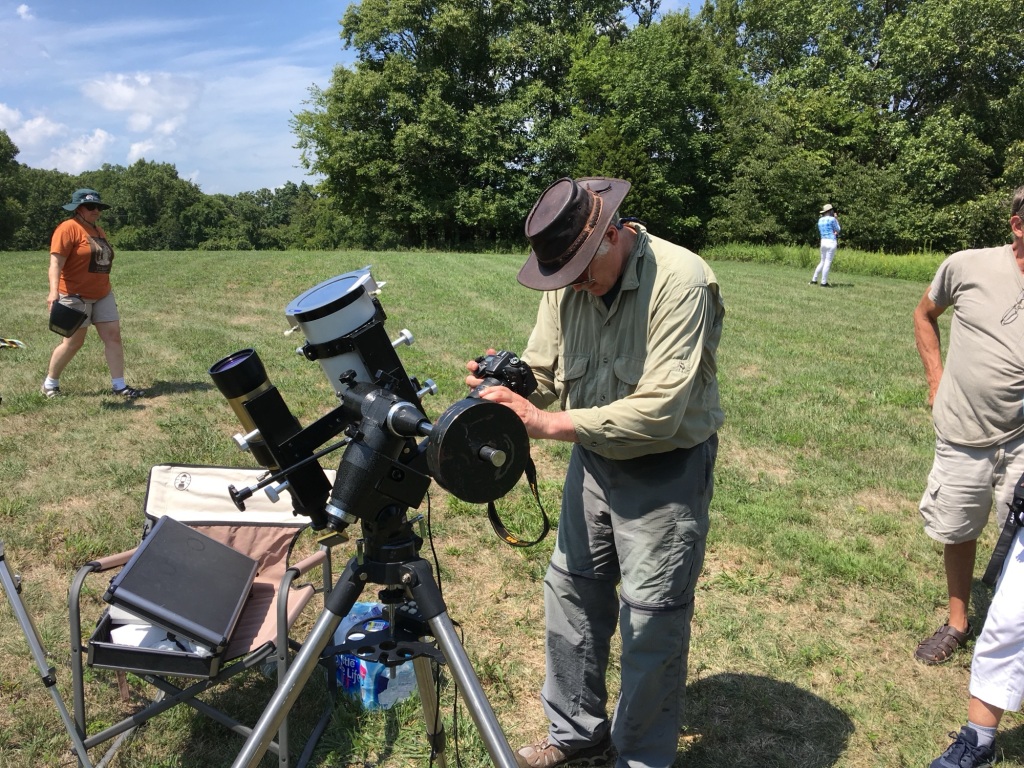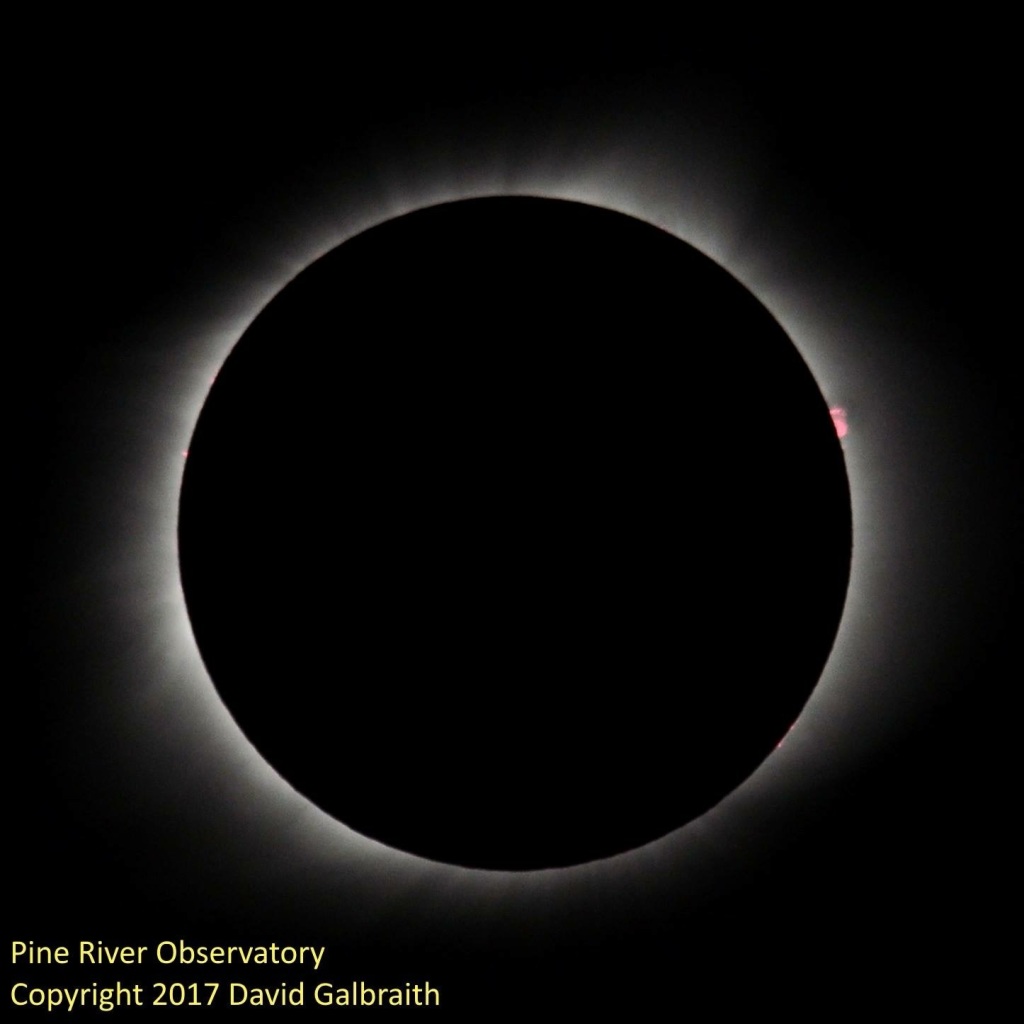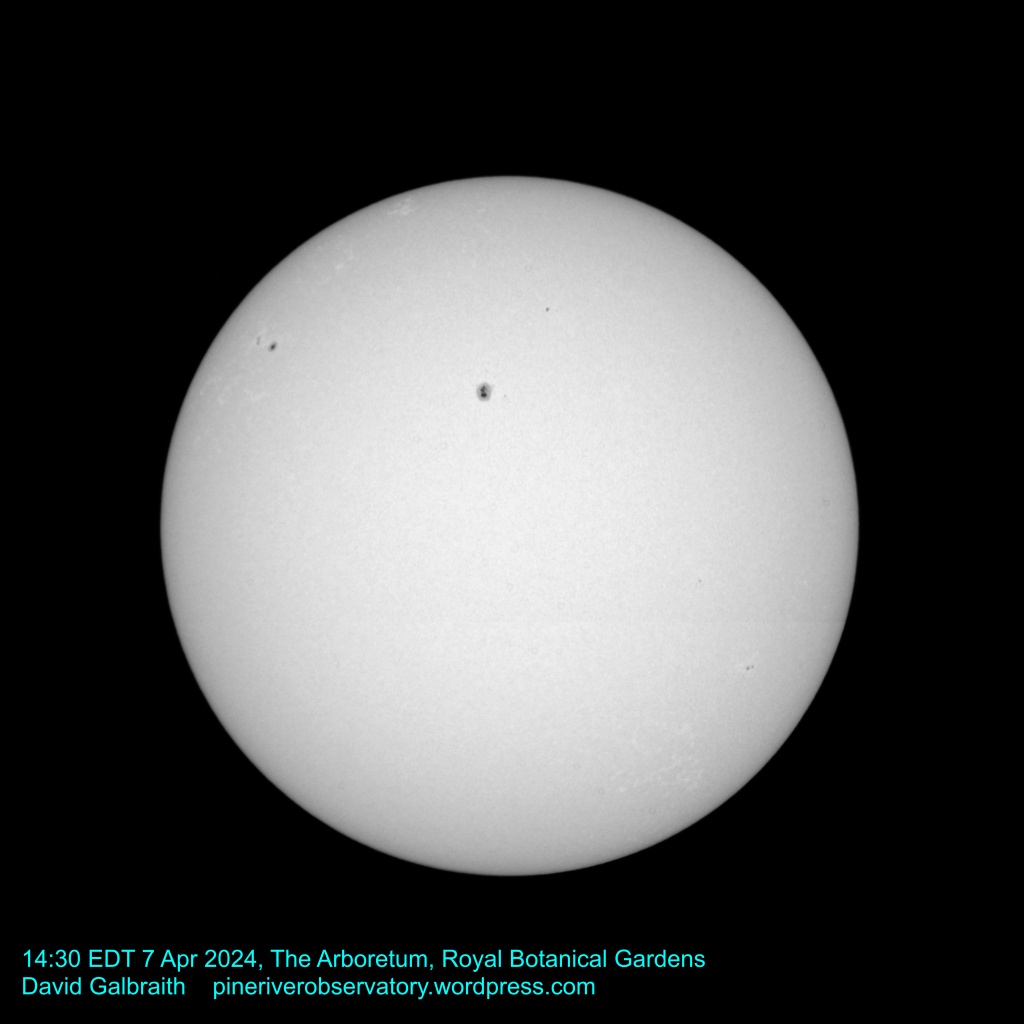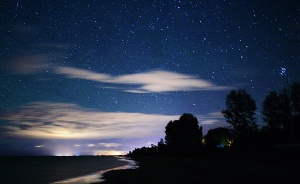Observing the 8 April 2024 Total Solar Eclipse at the Arboretum of Royal Botanical Gardens (Canada) in Hamilton, Ontario.
The total solar eclipse of 8 April 2024 that swept across North America caused an enormous public and media sensation. Millions of people were able to take in this beautiful natural phenomenon.
Here at Pine River Observatory (which is both virtual and portable) I’m going to post a couple of blog entries about my experience with the 2024 eclipse. I had the wonderful opportunity to participate in preparation for and leading the programming of a visitor experience for the eclipse at Royal Botanical Gardens (Canada), in Hamilton, Ontario, where I serve as Director of Science. In this first blog post describe the preparations for the event, which was held in the Arboretum of Royal Botanical Gardens (Canada) on the afternoon of April 8th.
Preparations for the event actually began about three years ago. I had traveled to the United States to witness the 2017 total solar eclipse that was sometimes called the Great American Eclipse. I joined friends south of St. Louis, MO, and experienced my first total solar eclipse. I also had the honour to serve as interpreter and observation guide for the group, which included members of The Explorers Club, St. Louis Chapter.

The 2017 eclipse was a chance to prepare solar observation telescopes and some camera equipment to record the event. That event went pretty well, and I was excited to capture a variety of images. I also demonstrated that my small telescope, a 5 inch Meade Terabeam Maksutov-Cassegrain OTA with a two inch Jim Weggat optical back, performed very well for visual observations and photography when equipped with a mylar solar filter from Kendrick.

In 2021 I first started bringing the 2024 eclipse to the attention of the interpretive and planning staff at Royal Botanical Gardens (Canada), with information about the path of totality and its duration. The Arboretum at University of Guelph was just inside the path of totality, with eclipse websites indicating 87 seconds of totality could be expected there. It was not hard to work with online ephemeris sites and get the direction and the elevation expected for the sun and moon at totality. This would be just about southwest, at 45° elevation.
Serious planning for the event at the Arboretum began in mid 2023, when our director of business development and I started to discuss just what was practical and possible on the day. While the astronomical portion of the eclipse was very predictable, the wildcard in all of this was the weather. We were expecting a 60% probability of being clouded out on the day of the eclipse. Historical weather information, however, is proving to be somewhat unreliable in the era of climate change we are now experiencing. The two days before the eclipse the weather turned out to be cloudless and beautiful. Of course, we did not know this in our planning.
Prior to the eclipse itself RBG organized a presentation by eclipse chaser David Makepeace, of Toronto, a videographer who has identified himself as The Eclipse Guy. David has traveled the world many times to take in eclipses, and gave a wonderful presentation on eclipse chasing at RBG two weeks before the event itself.
We also teamed up with two other institutions in preparation for the eclipse. The Ontario Science Centre in Toronto included RBG in some of its own planning, and sent a team to RBG for the day of the eclipse. This was done in part because the Ontario Science Centre was to be outside of the path of totality. The other partner was McMaster University, which made the wonderful donation of several thousand eclipse glasses to RBG for distribution during our programming. In total McMaster University had over 600,000 pairs of eclipse glasses prepared and distributed free in Hamilton to give people a chance to observe the eclipse in safety.
To set up for the eclipse, it was decided that the Arboretum on the North Shore of Cootes Paradise Marsh would be the best place for an RBG eclipse viewing. It’s not that the Arboretum is anything particularly special, but it does present a large grassy area with a good view to the southwest. Our food services department set up a food truck, and our operations and events people set out chairs, tables, and even fire pits across the Arboretum so that visitors could relax and enjoy the event in style.
I decided to set up a couple of cameras and my five inch telescope 5 inch telescope so that people could take a look at the eclipse in its partial phases through the filtered telescope. On 7th of April, the day before the eclipse, I set up all of my equipment in the Arboretum and did a practice run with solar imaging, producing a decent visual light image of the solar disk.

I disassembled the equipment and packed it back up into my car for the overnight wait, and then arrived at the Arboretum around 11:30 on the morning of 8th April. It took a while to set up the equipment, but I decided to do a very simple thing with my telescope. Critical to any observed observations with a telescope is the telescope mount. In my case I have an old mount of about an EQ3 size (I’m not even certain), and I decided I was going to use it simply as a manually-moved German Equatorial manual mount. I made a rough north alignment, and then set up the optical tube assembly, the mylar solar filter, and eyepiece.
For camera equipment I had a Nikon D 7000 with a 150 to 500mm telephoto lens and yellow plastic solar filter. I used the handheld camera to take pictures of the sun and moon at various times. At totality, I removed the filter so that I could get photographs of the totality event.
And that was about it. I set up my relatively simple telescope, and during the day I was aided by several RBG volunteers, a wonderful group who come out to help at nearly every event. The wait was on to see if we would get an eclipse, because early on the morning of the 8th of April the weather forecast did not look very good. We had solid cloud until at least 1:00 PM, with totality scheduled for about 3:20 PM.
I’m going to pick up the story of the actual eclipse event in our next blog post. I’ll review the programming and experience of eclipse day, observations and the interactions with all of the public who joined us on the event, and share some photographs. We had at least 400 people attend. It’s not giving anything away at this stage to say that we did see a wonderful eclipse, the clouds cooperated in a rather dramatic fashion, and it was my impression everyone was very excited and satisfied that day.


